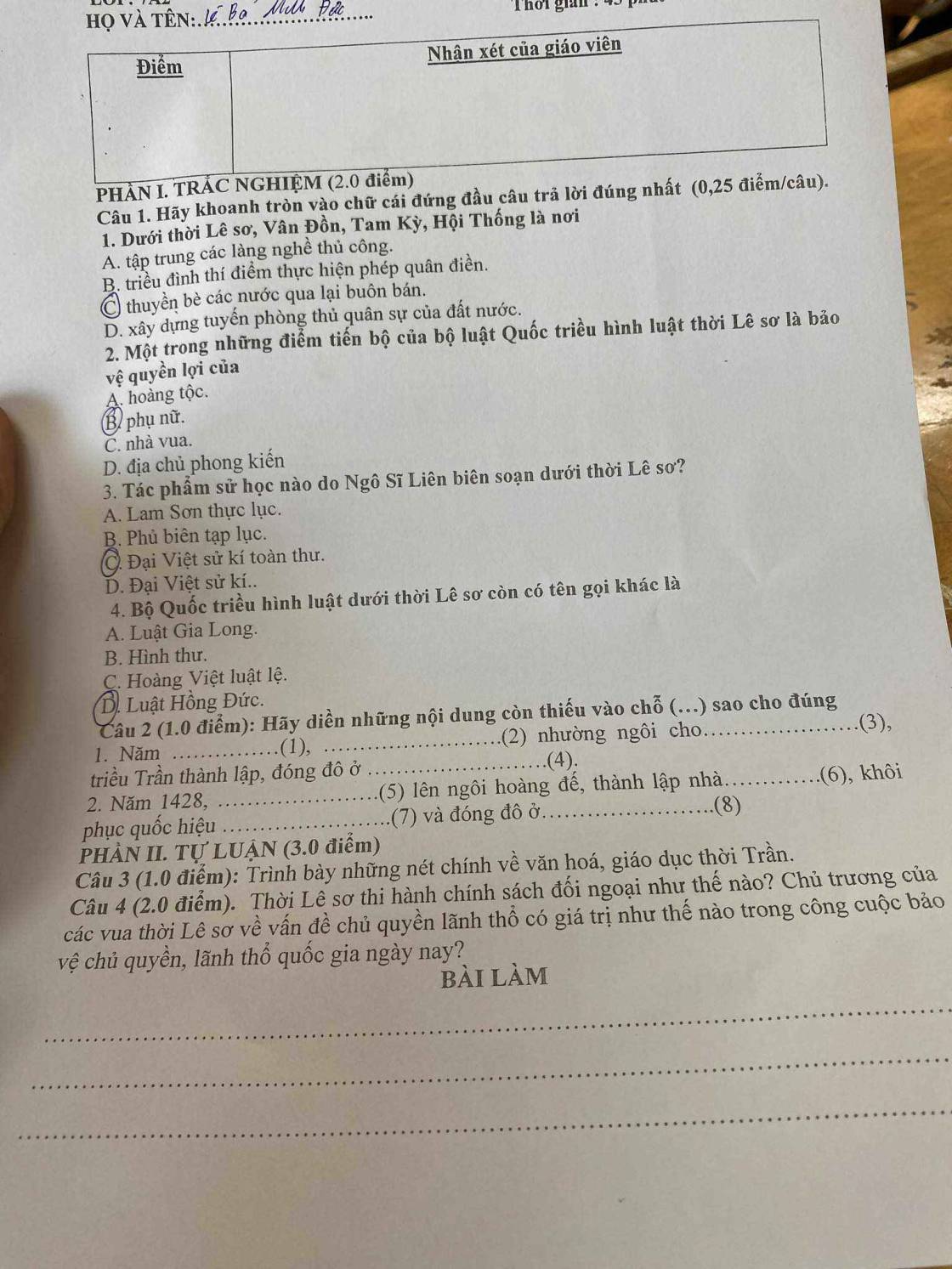 ét ô ét ạ mik cần gấp lắm :((
ét ô ét ạ mik cần gấp lắm :((
Hãy nhập câu hỏi của bạn vào đây, nếu là tài khoản VIP, bạn sẽ được ưu tiên trả lời.


a....cả lớp đã như cái chợ vỡ
b. , gió càng mạnh lên bấy nhiêu
a)Cô giáo vừa ra ngoài, các bạn học sinh trong lớp đã nói chuyện riêng với nhau.
b)Mưa càng lớn bao nhiêu, gió càng lớn bấy nhiêu.


a: A(x)=x^5+3x^4-2x^3-9x^2+11x-6
B(x)=x^5+3x^4-2x^3-10x^2+9x-8
C(x)=A(x)-B(x)
=x^5+3x^4-2x^3-9x^2+11x-6-x^5-3x^4+2x^3+10x^2-9x+8
=x^2+2x+2
b; C(x)=2x+2
=>x^2=0
=>x=0
c: C(x)=2012
=>x^2+2x-2010=0
Δ=2^2-4*1*(-2010)=8044>0
=>Phương trình có hai nghiệm phân biệt là:
\(\left\{{}\begin{matrix}x_1=\dfrac{-2-\sqrt{8044}}{2}\simeq-45,84\left(loại\right)\\x_2=\dfrac{-2+\sqrt{8044}}{2}\simeq43,84\left(loại\right)\end{matrix}\right.\)
=>Ko có giá trị nguyên của x thỏa mãn

>In 100 years, there’ll be too many people on Earth. So I think we have big city space. People will live space station. Children will also go to school space station. There will be special classroom for learning more about new life in space.
>Maybe children will have robots help them go to school. And turn them get up on the bed….
>The robots will be like a best friend for the children because they will talk to them and help them with any problems.
> I think children will still go to normal school and learn from their teachers. The only different is that all children will have their own computers in the classroom. There will be a lot more machines to help us learn.
As city space becomes more squeezed, we will burrow deeper and build higher with the creation of:
As technology develops, we’ll see:

May 1 bộ hết số mét vải là:
27 : 5 = 5,4 (m)
May 16 bộ quần áo hết số mét vải là:
5,4 x 16 = 86,4 (m)
Đáp số: 86,4 m vải


Lời giải:
Gọi $d=ƯCLN(3n+2, 2n+3)$
$\Rightarrow 3n+2\vdots d; 2n+3\vdots d$
$\Rightarrow 3(2n+3)-2(3n+2)\vdots d$
$\Rightarrow 5\vdots d$
$\Rightarrow d=1$ hoặc $d=5$.
Để ps đã cho là tối giản thì $d\neq 5$. Nghĩa là $2n+3\not\vdots 5$
$\Rightarrow 2n-2\not\vdots 5$
$\Rightarrow 2(n-1)\not\vdots 5$
$\Rightarrow n-1\not\vdots 5$
$\Rightarrow n\neq 5k+1$ với $k$ tự nhiên.

\(\left(3+5+7+...+2021\right)\times\left(6,2:0,25-2,48\times10\right)\)
\(=\left(3+5+7+...+2021\right)\times\left(24,8-24,8\right)\)
\(=\left(3+5+7+...+2021\right)\times0\)
\(=0\)

4:
a: -90<a<0
=>cos a>0
cos^2a=1-(-4/5)^2=9/25
=>cosa=3/5
\(sin\left(45-a\right)=sin45\cdot cosa-cos45\cdot sina=\dfrac{\sqrt{2}}{2}\left(cosa-sina\right)\)
\(=\dfrac{\sqrt{2}}{2}\left(\dfrac{3}{5}-\dfrac{4}{5}\right)=\dfrac{-\sqrt{2}}{10}\)
b: pi/2<a<pi
=>cosa<0
cos^2a+sin^2a=0
=>cos^2a=16/25
=>cosa=-4/5
tan a=3/5:(-4/5)=-3/4
\(tan\left(a+\dfrac{pi}{3}\right)=\dfrac{tana+\dfrac{tanpi}{3}}{1-tana\cdot tan\left(\dfrac{pi}{3}\right)}\)
\(=\dfrac{-\dfrac{3}{4}+\sqrt{3}}{1-\dfrac{-3}{4}\cdot\sqrt{3}}=\dfrac{48-25\sqrt{3}}{11}\)
c: 3/2pi<a<pi
=>cosa>0
cos^2a+sin^2a=1
=>cos^2a=25/169
=>cosa=5/13
cos(pi/3-a)
\(=cos\left(\dfrac{pi}{3}\right)\cdot cosa+sin\left(\dfrac{pi}{3}\right)\cdot sina\)
\(=\dfrac{5}{13}\cdot\dfrac{1}{2}+\dfrac{-12}{13}\cdot\dfrac{\sqrt{3}}{2}=\dfrac{5-12\sqrt{3}}{26}\)

caanf câu 2 đến hết tự luận à bn
từ phần tự luận thôi ạ